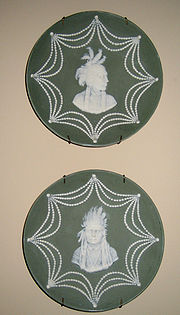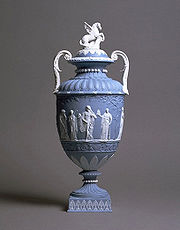
Jasperware
Encyclopedia


Stoneware
Stoneware is a vitreous or semi-vitreous ceramic ware with a fine texture. Stoneware is made from clay that is then fired in a kiln, whether by an artisan to make homeware, or in an industrial kiln for mass-produced or specialty products...
first developed by Josiah Wedgwood
Josiah Wedgwood
Josiah Wedgwood was an English potter, founder of the Wedgwood company, credited with the industrialization of the manufacture of pottery. A prominent abolitionist, Wedgwood is remembered for his "Am I Not A Man And A Brother?" anti-slavery medallion. He was a member of the Darwin–Wedgwood family...
, although some authorities have described it as a type of porcelain
Porcelain
Porcelain is a ceramic material made by heating raw materials, generally including clay in the form of kaolin, in a kiln to temperatures between and...
. It is noted for its matte finish and is produced in a number of different colours, of which the best known is a pale blue that has become known as 'Wedgwood Blue'.
The term "jasper
Jasper
Jasper, a form of chalcedony, is an opaque, impure variety of silica, usually red, yellow, brown or green in color; and rarely blue. This mineral breaks with a smooth surface, and is used for ornamentation or as a gemstone. It can be highly polished and is used for vases, seals, and at one time for...
" is not the personal name Jasper
Jasper (name)
Jasper is a given name. The name means "spotted or speckled stone" and is derived from Greek iaspis, It is a variation of the Persian Kaspar. According to the Biblical tradition Casper is the name of one of the "Three Kings", who presented Christ gifts. Casper gave frankincense...
in this context, but the name of a mineral; it comes from the Greek iaspis, itself of oriental origin and related to the Hebrew yashpeh, for an opaque variety of quartz, usually red, yellow or brown.
Dating Jasperware
Wedgwood jasperware can often be dated by the style of potter's marks, although there are exceptions to the rules:- Before 1860: Mark is "Wedgwood". Usually accompanied by other potter markings and a single letter.
- After 1860: A three-letter mark represents in order, the month, the potter, and the year. The year code starts mid-alphabet with the letter "O" for 1860, the letter "P" for 1861, etc., returning to "A" after "Z". For certain letters there are two possible year dates.
- 1891-1908: Marks are "Wedgwood", "England", separated.
- 1908-1969: Marks are "Wedgwood", "Made in England", separated, or "Wedgwood England" on small objects like thimbles.
- 1970-present: Mark is "Wedgwood Made in England" as single stamp
Wedgwood
Wedgwood's main designs are jasperware and black basalt. Many of the Wedgwood designs were based on the art of making cameo glassCameo Glass
Cameo glass is a luxury form of glass art produced by etching and carving through fused layers of differently colored glass to produce designs, usually with white opaque glass figures and motifs on a dark-colored background...
and on the looks of The Portland Vase
Portland Vase
The Portland Vase is a Roman cameo glass vase, currently dated to between AD 5 and AD 25, which served as an inspiration to many glass and porcelain makers from about the beginning of the 18th century onwards. Since 1810 the vase has been kept almost continuously in the British Museum in London...
.
External links
- Wedgwood buttons, made 1785-1800, from the Victoria & Albert MuseumVictoria and Albert MuseumThe Victoria and Albert Museum , set in the Brompton district of The Royal Borough of Kensington and Chelsea, London, England, is the world's largest museum of decorative arts and design, housing a permanent collection of over 4.5 million objects...
jewellery collection.

